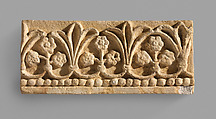Wall decoration with floral and vegetal design
Not on view
Stucco reliefs were commonly used to decorate the iwans and reception halls of elite Sasanian houses. Many examples were found in excavated houses in the Ctesiphon area including this relief consisting of three small flowers alternating between palm leaves with a beaded border below. The design was found at houses in both Ma’aridh IV and Umm ez-Za’tir and this relief is reconstructed from fragments from both sites. The use of molds to make stuccos allowed for the creation of large scale repetitive patterns such as floral and vegetal motifs.
The city of Ctesiphon was located on the east bank of the Tigris River, 20 miles (32 km) south of modern Baghdad in Iraq. It flourished for more than 800 years as the capital of the Parthians and the Sasanians, the last two dynasties to rule the ancient Near East before the Islamic conquest in the seventh century. Systematic excavations in the Ctesiphon area were undertaken by an expedition in 1928–29 sponsored by the German Oriental Society (Deutsche Orient-Gesellschaft). The Metropolitan Museum of Art and the Staatliche Museen, Berlin, undertook a joint expedition for one season in 1931–32. Several excavations were conducted, including at the main palace (Taq-i Kisra), in a small fortified area south of the palace at Tell Dheheb, at multiple houses at the mounds of Ma’aridh, and at additional houses at a small mound called Umm ez-Za’tir.
Over the course of the excavations in the Ctesiphon area, six houses from a series of small mounds called el Ma’aridh were excavated. These houses follow typical Sasanian design with a mix of square and elongated rooms. The house at Ma’aridh IV was partially excavated and the exposed portions show both service and reception areas of the house. In the northeast corner of the excavations two rooms, one with pillars, were decorated with stuccos. A large courtyard with four niches probably was the center of the house. The southwest rooms seem to be more functional in nature and may have served as service rooms. One room may have functioned as a bath as indicated by the water channels excavated. A large house such as Ma’aridh IV was clearly an elite household as demonstrated by its large size (1200 square meters were excavated) and the decorated rooms.
Excavations were also conducted at a small mound approximately 2 km east of the Taq-I Kisra called Umm ez-Za’tir or Mother of Thyme where rooms associated with housing were exposed. Excavations conducted in the winters of 1928/1929 and 1931/1932 revealed the plan of a 6th century Sasanian house following the typical plan of a mix of square and elongated rooms. Iwans were found on the east and west walls which were decorated with stucco reliefs on the walls and on the arches.
#7081. Overview: The Sassanian Empire
Due to rights restrictions, this image cannot be enlarged, viewed at full screen, or downloaded.

